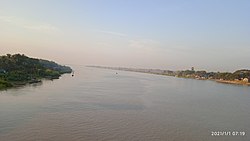Bago River
| Bago River | |
|---|---|
 | |
| Native name | Burmese:ပဲခူးမြစ် |
| Location | |
| Country | Myanmar |
| Region | |
| Townships | |
| Cities | |
| Physical characteristics | |
| Source | Sinhnamaung Mountain,Gyobingauk Township,Bago, Myanmar[1] |
| • coordinates | 18°23′50″N95°55′1″E/ 18.39722°N 95.91694°E |
| • elevation | 800 m (2,600 ft) (approximately) |
| 2nd source | Dawe Dam and Reservoir,Letpadan Township,Bago, Myanmar |
| • coordinates | 17°45′20″N96°11′46″E/ 17.75556°N 96.19611°E |
| • elevation | 80 m (260 ft) (approximately) |
| Mouth | Yangon River |
• location | Monkey Point,Yangon,Myanmar |
• coordinates | 16°45′57″N96°11′48″E/ 16.76583°N 96.19667°E |
• elevation | 1 m (3.3 ft) |
| Length | 331 km (206 mi)[2] |
| Basin size | 3,220 km2(1,240 sq mi)[2] |
| Width | |
| • average | 150 m (490 ft)[3] |
| • maximum | 1,200 m (3,900 ft) |
| Discharge | |
| • location | Yangon River |
| Basin features | |
| Progression | Bago River→Yangon River→Andaman Sea |
| Tributaries | |
| • left | |
| • right | Bago-Sittaung Canal |

Bago River(Burmese:ပဲခူးမြစ်;Pegu River) is a river of southernMyanmar.It flows throughBagoandYangon,joining theYangon Riversouth of downtown Yangon.[4]
The source of the Bago river comes from many streams in the hills of thePegu Range[5]with the traditional choice for the source being Sinhnamaung Mountain inLetpadan Township.[1]Modern hydrological surveys find streams further north inPhyu Townshipthat feed into the Bago River Basin.[3]The Bago River flows into Yangon Region meeting the Yangon River at Monkey Point,Botahtaung Township,below which the river is called theYangon River.

In 1608, the Portuguese mercenaryFilipe de Brito e Nicote,known as Nga Zinka to the Burmese, plundered theShwedagon Pagoda.His men took the 300-tonGreat Bell of Dhammazediusing elephants and forced labour.[6]De Brito's intention was to melt the bell down to make cannons. but it fell into this river when he was carrying it across.[7]
Many people have tried to find the bell in the murky waters of the river, so far without success. Professional deep sea diver James Blunt has made 115 exploratory dives, usingsonarimages of objects in the area for guidance. To this date, it has not been recovered. Several Myanmar divers have died looking for it, including two navy divers who were trapped in a nearby wreck. The bell has since become an object of national superstition believing the search to be cursed and the bell's retrieval to be the key to the nation's rise out of poverty[6]
References
[edit]- ^abMyanmar Information Management Unit (December 19, 2019).Bago Myone Daethasaingyarachatlatmyaပဲခူမြို့နယ် ဒေသဆိုင်ရာအချက်လက်များ[Bago Township Regional Information](PDF)(Report). MIMU.RetrievedMarch 2,2022.
- ^abPhue, H.T.; Cheunchooklin, S. (2020)."Existing Water Balance in the Bago River Basin, Myanmar".IOP Conference Series: Earth and Environmental Science.552(552): 012003.doi:10.1088/1755-1315/552/1/012003.S2CID225252599.
- ^abWin, Shelly; Win Win Zin; Kawasaki, Akiyuki; Zin Mar Lar Tin San (June 2018)."Establishment of flood damage function models: a case study in the Bago River Basin, Myanmar".International Journal of Disaster Risk Reduction.28:688–700.doi:10.1016/j.ijdrr.2018.01.030.S2CID135356664.
- ^Schellinger, Paul E. and Salkin, Robert M. (editors) (1996) "Bago (Myanmar)"International Dictionary of Historic Places: Asia and Oceania(volume 5) Fitzroy Dearborn Publishers, Chicago, pp. 60-65,page 60,ISBN1-884964-04-4
- ^Seekins, Donald M. (2006)Historical dictionary of Burma (Myanmar)Scarecrow Press, Lanham, Maryland,page 357,ISBN0-8108-5476-7
- ^abAung Zaw (23 February 2018)."Chiming with History".The Irrawaddy.The Irrawaddy.RetrievedMarch 5,2022.
- ^"Myanmar's Largest Bell Underwater".Yangon, Myanmar: Myanmar's NET. 2007. Archived fromthe originalon 13 April 2010.Retrieved22 May2010.
